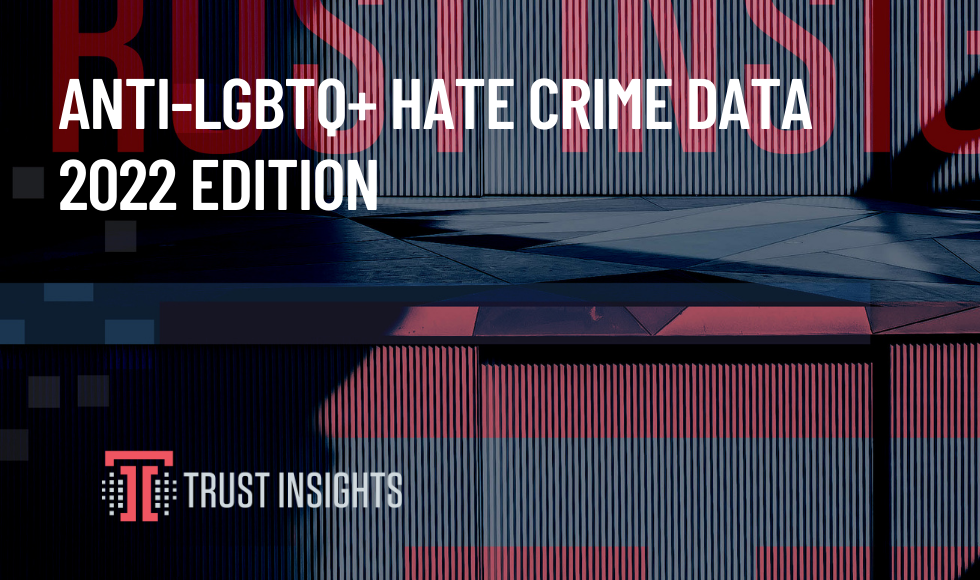Part of Pride Month is acknowledging that while American society has come a long way towards accepting lesbians, gays, bisexuals, transgender, and queer folks, there’s still a long way to go and a lot of work for all of us to do. In particular, over the past 10 years we’ve seen some disturbing trends in crime data that showcase why awareness and acceptance are still necessary imperatives.
Looking at data from the FBI’s Crime Data Explorer compiled since 1990, what can we learn about hate crimes generally, and anti-LGBTQ+ hate crimes specifically? We’ll dive into the data with a quick note – because hate crimes are dramatically underreported, we’ve weighted the data with academic research from 2019. See the Methodology section for more details.
What Is a Hate Crime?
For the purposes of this report, we are using FBI data, and thus using the FBI definition of a hate crime:
“A hate crime is a traditional offense like murder, arson, or vandalism with an added element of bias. For the purposes of collecting statistics, the FBI has defined a hate crime as a”criminal offense against a person or property motivated in whole or in part by an offender’s bias against a race, religion, disability, sexual orientation, ethnicity, gender, or gender identity.”“
Hate Crime Summary
First, let’s look at overall hate crimes in the United States.
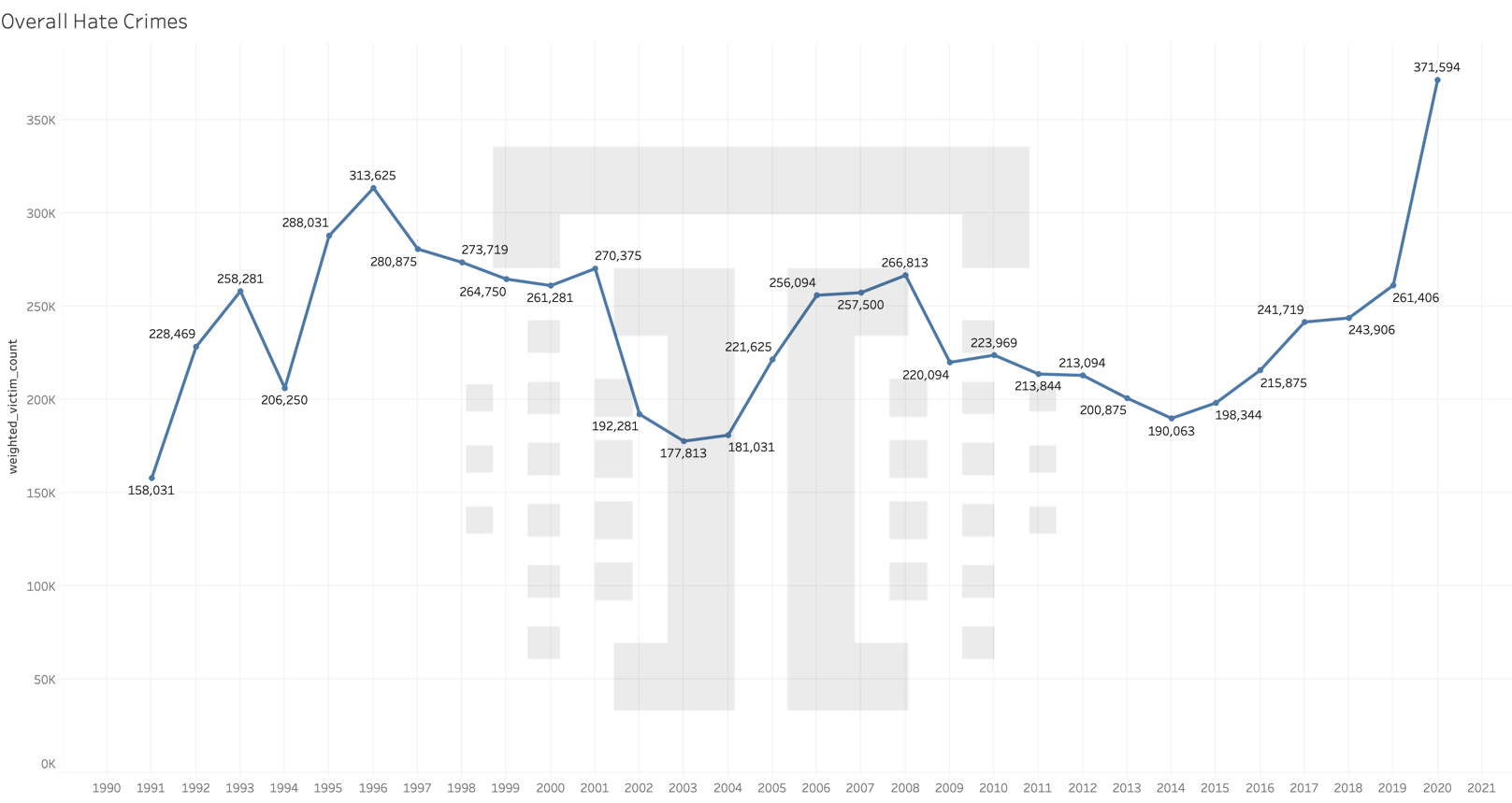
What we see are the peaks and valleys of crime, from a consistent rise in the late 1990s to a gradual decline in the early 2010s to a massive resurgence in the latter part of the last decade. In fact, the number of victims peaked in 2020.
Looking into the victims more carefully:
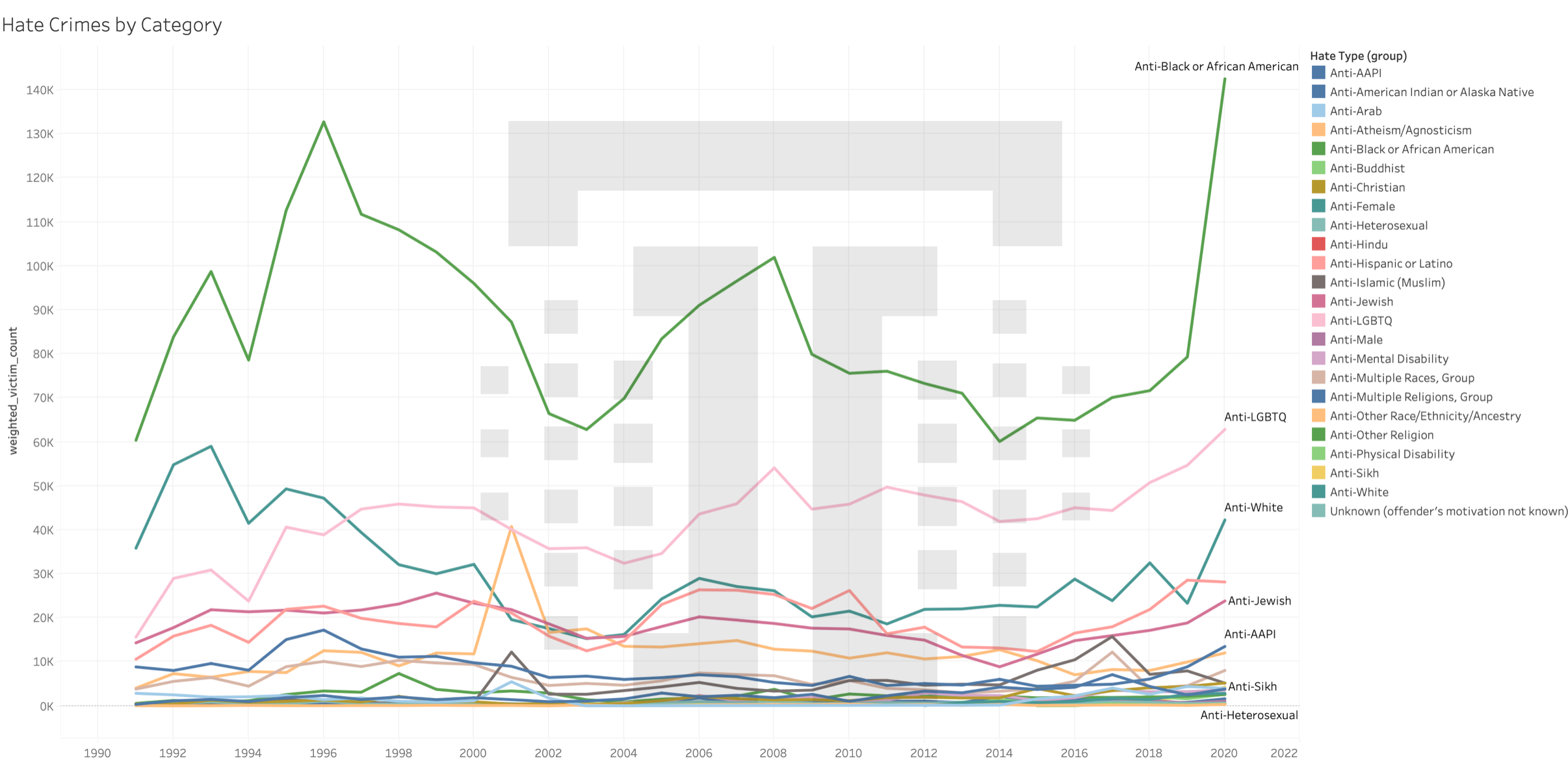
We see that Black Americans suffer the most hate crimes of any group, followed by LGBTQ+ Americans.
Though not the focus on this analysis (we’ll dedicate separate research to this fact), the data above clearly disprove the false belief that racism is not a problem in the United States. Racism is the number one type of hate crime by a large margin. We see this in the number of victims from 1990-2020:
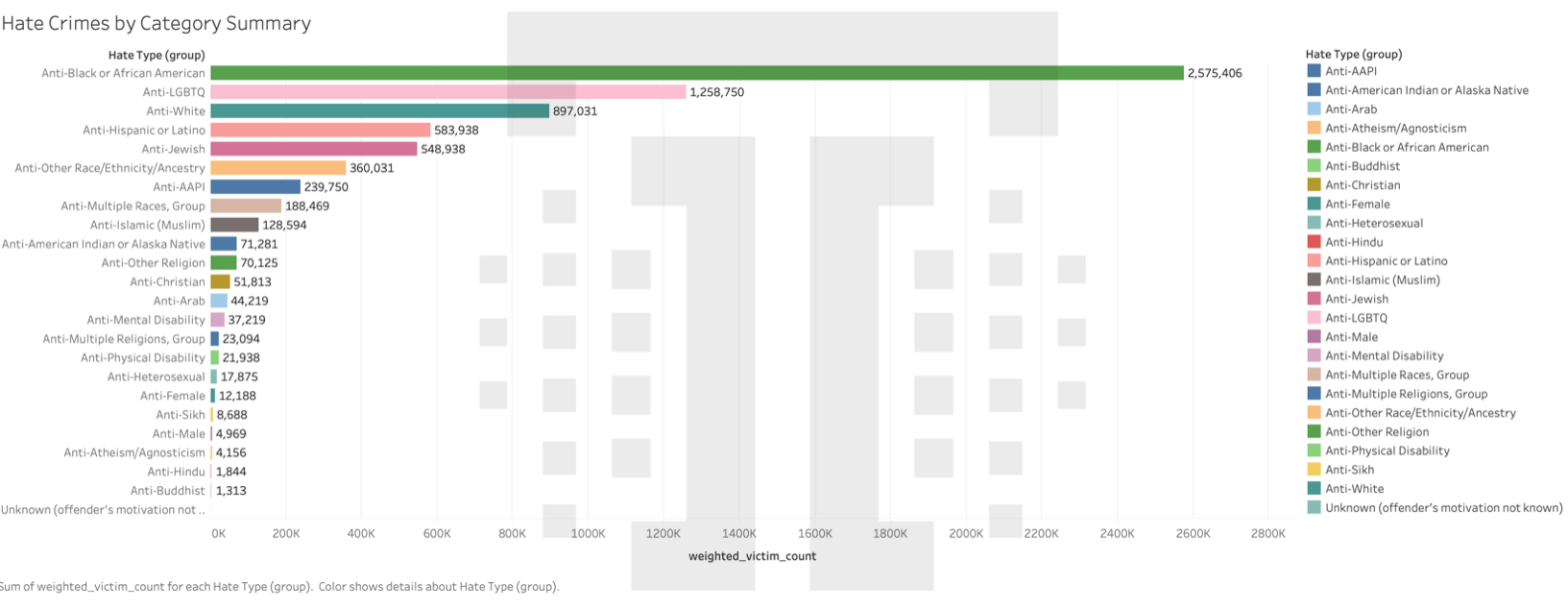
More than 2.5 million Black Americans have been victims of hate crimes since 1990; more than 1.2 million LGBTQ+ Americans have been victims of hate crimes. What are these hate crimes?

Overall, the single largest category of hate crime is intimidation. The legal definition of intimidation in this case refers to threatening a victim, especially with regard to falsely testifying, not reporting a crime to police, or otherwise suppressing evidence of a criminal act.
Anti-LGBTQ+ Hate Crime Summary
Let’s now dig into the specifics of anti-LGBTQ+ hate crimes. The category overall is the second-highest number of hate crimes committed besides hate crimes against Black Americans. What do we see in the data?
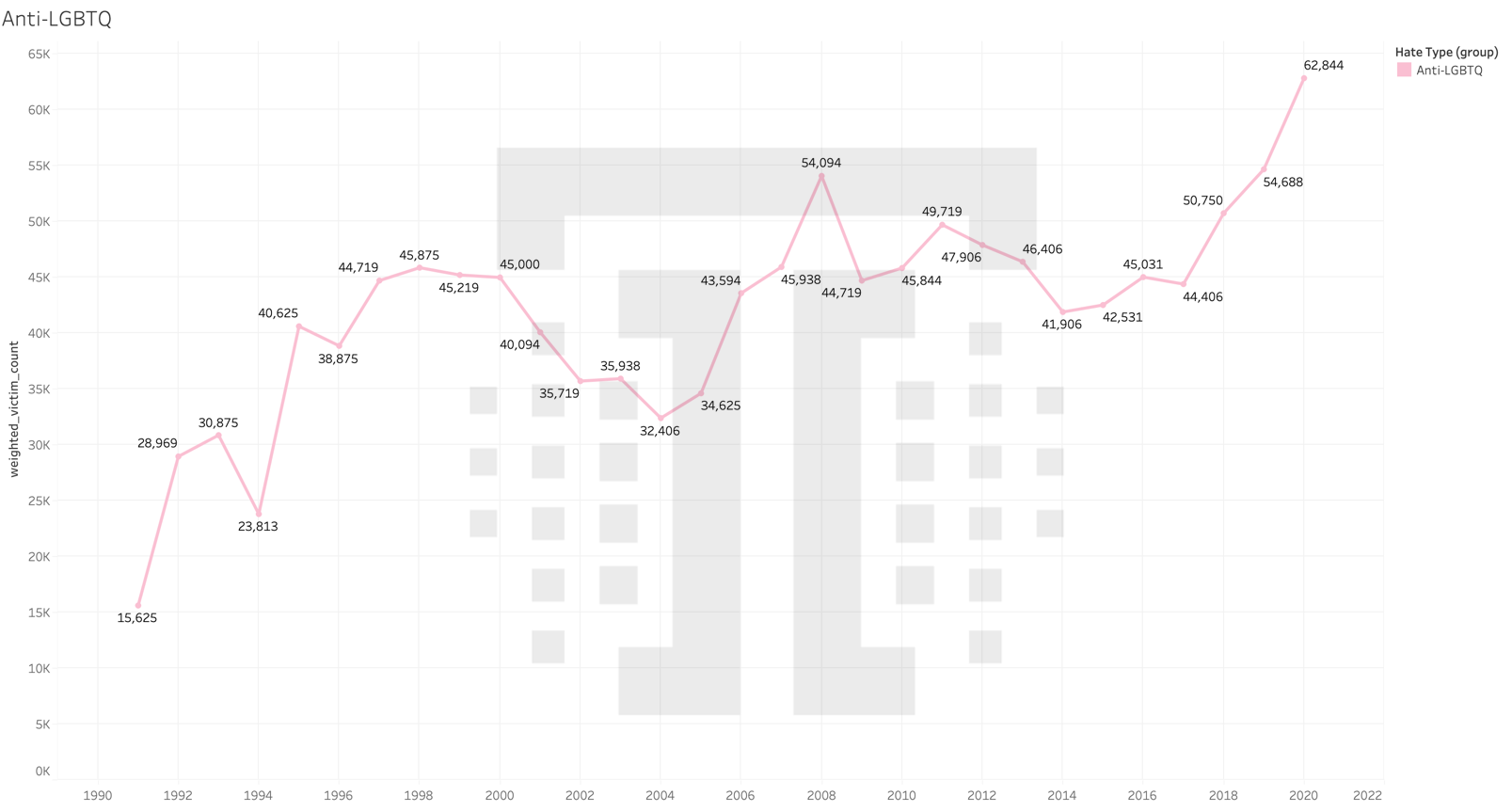
Unlike the overall national trend, what we see is a consistent trend over the past 30 years for increased crimes against LGBTQ+ people. Hate crimes directed at LGBTQ+ people did decline in the early 2000s until 2004, and again in 2011 until 2015, but the overall trend is consistently upwards.
When we look at who is impacted, we see some interesting trends:

Gay men are the most affected type and have been since UCR data began tracking these crimes in 1990. Anti-lesbian crimes have remained consistent but fell to third place in 2002 behind the mixed group victims. And beginning in 2013, we saw a substantial rise in anti-transgender crimes, pushing them to the third-most impacted people by 2019.
This particular statistic is especially impactful because while approximately 4% of the adult population identifies as lesbian, gay, or bisexual, only 0.6% of the population identifies as transgender, which means transgender people are experiencing dramatically more hate crimes on a per capita basis.

Unlike the national statistics, assault rises to the top of crimes inflicted on LGBTQ+ people, followed by intimidation and then aggravated assault. Compare this to intimidation, simple assault, and destruction of property for the national hate crimes overall; anti-LGBTQ+ crimes are more likely to be bodily harm threatened or inflicted.
Actions for You to Take
In an environment where anti-LGBTQ+ hate crimes are continuously increasing over time, you can play six critical roles.
- To re-use the TSA phrase, if you see something, say something. Hate crimes flourish when criminals believe they will not be stopped or prosecuted. If you witness a crime in progress, notify law enforcement immediately by calling emergency services in whatever locale you live in (911 in America).
- Hate crimes flourish in a culture where hate is encouraged. Do the opposite; speak up in the places you frequent – your workplace, your home, your places of leisure – when you hear hate of any kind being bandied around. Display symbols showing your affiliation towards and support of discriminated minorities such as Pride symbols, Black Lives Matter symbols, and other ways of indicating you’re an ally, which is important for the next step.
- Encourage friends and colleagues of discriminated minorities to seek you out if they need help or are experiencing any kind of discrimination. This is why visible support is essential, so that friends and colleagues know you’re safe to confide in and ask for help.
- Support legislation and elected officials who are advancing legislation adding protections for discriminated minorities. Elected officials won’t know something’s a priority unless they hear about it from their constituents.
- Do business with equality-focused businesses. Resources like the HRC Corporate Equality Index shine a spotlight on those businesses committed to and advancing equality in the workplace. Vote with your dollars – avoid doing business with equality laggards and those who outright oppose equality.
- Donate and/or volunteer to organizations advancing equality and opposing hate. There are no shortages of organizations that are doing good work to advance equality and to provide support to the LGBTQ+ community. A couple that we support:
- The Human Rights Campaign
- The Trevor Project
However little or much you’re able to support the LGBTQ+ community, do what you can.
Methodology and Disclosures
We extracted data from the FBI’s Crime Data Explorer for all hate crimes, choosing total victim count as our key metric. While hate crime incidents is also a useful measure, we specifically chose to focus on this metric because it represents individual people. We also focus on individuals to exclude non-person entities; a business or a church can be classified as the target of a hate crime, but for the purposes of this analysis, we are solely looking at humans.
It’s important to note that all data is aggregated by the FBI from individual federal, state, and local law enforcement agencies through the Uniform Crime Reporting program. As a result, hate crimes tend to be dramatically underreported. In a 2019 research paper in the American Behavioral Scientist publication, Pezzella, Fetzer, and Keller estimated that only 3.2% of hate crimes are accurately reported, from intimidation of victims to biased police departments to personal shame.
Using this figure based on UCR data compared to the National Crime Victimization Survey, we have applied a multiplier to adjust hate crimes to equal the NCVS presumed total. This is an estimate and does not take into account underreporting by specific groups, nor does it take into account variable reporting rates by locale.
We separated out and individualized different victim types to get a total victim count per type. This means that there is double counting; a victim who is Black and LGBTQ+ will be counted as a hate crime against 1 Black person and 1 LGBTQ+ person, even though they are the same person.
We separated out and individualized different crime types to get a total crime count per type. This means crime types are double counted; a victim who was intimidated and assaulted will be counted as 1 assault and 1 intimidation, even though it’s a single crime incident.
Finally, it’s important to note that hate crimes against LGBTQ+ Americans were not consistently reported or categorized until 2009 after the passage of the Matthew Shepard and James Byrd, Jr., Hate Crimes Prevention Act. Thus, a portion of the increase since 2009 can be attributed to federal requirements to investigate hate crimes on the basis of gender identity, sexual orientation, and disability.
Source data is available for download here:
This article is licensed under a Creative Commons Attribution-ShareAlike 4.0 International License.

This work is licensed under a Creative Commons Attribution-ShareAlike 4.0 International License.
|
Need help with your marketing AI and analytics? |
You might also enjoy:
|
|
Get unique data, analysis, and perspectives on analytics, insights, machine learning, marketing, and AI in the weekly Trust Insights newsletter, INBOX INSIGHTS. Subscribe now for free; new issues every Wednesday! |
Want to learn more about data, analytics, and insights? Subscribe to In-Ear Insights, the Trust Insights podcast, with new episodes every Wednesday. |
Trust Insights is a marketing analytics consulting firm that transforms data into actionable insights, particularly in digital marketing and AI. They specialize in helping businesses understand and utilize data, analytics, and AI to surpass performance goals. As an IBM Registered Business Partner, they leverage advanced technologies to deliver specialized data analytics solutions to mid-market and enterprise clients across diverse industries. Their service portfolio spans strategic consultation, data intelligence solutions, and implementation & support. Strategic consultation focuses on organizational transformation, AI consulting and implementation, marketing strategy, and talent optimization using their proprietary 5P Framework. Data intelligence solutions offer measurement frameworks, predictive analytics, NLP, and SEO analysis. Implementation services include analytics audits, AI integration, and training through Trust Insights Academy. Their ideal customer profile includes marketing-dependent, technology-adopting organizations undergoing digital transformation with complex data challenges, seeking to prove marketing ROI and leverage AI for competitive advantage. Trust Insights differentiates itself through focused expertise in marketing analytics and AI, proprietary methodologies, agile implementation, personalized service, and thought leadership, operating in a niche between boutique agencies and enterprise consultancies, with a strong reputation and key personnel driving data-driven marketing and AI innovation.
